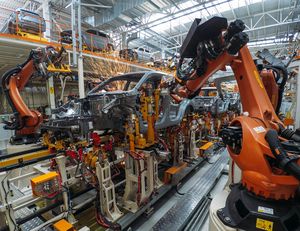KANBrief 4/18

In other countries, Japan generally has the reputation of being a pioneer in robotization. Not only does Japanese industry possess the greatest number of installed robots worldwide, robots are now also finding their way into many areas of everyday life. However, some of Japan's most successful companies have a more nuanced attitude to robots, notably the flagship company of Japanese industry, the Toyota Motor Corporation.
"Robots cannot improve processes. Only our employees can do that." This approach, often cited by managers, is rooted in Toyota's history. In the mid-1980s, facing an acute shortage of labour, the company launched an experiment in its Tahara plant: all assembly stations involving heavy components were automated, and sealed off hermetically for reasons of safety and health.
The number of production workers was reduced significantly as a result. A large number of technical staff were required in production however, in order to assure the availability of the complex technology. One parameter in particular demonstrated that the adopted approach was not forward-thinking: the number of suggestions by workers for possible improvements dropped dramatically. The reason was obvious: very few workers performed the automated processes themselves, or even observed them.
The experience gained in Tahara ultimately led to a new concept for final assembly. An optimum combination of workers and automation was now sought, and priority given to ergonomics. Carefully crafted equipment was made available to support workers in all physically demanding tasks. This equipment was often the result of suggestions made by the workers themselves. Cycle times of approximately one minute and the strong importance attached to added value result in repetitive tasks with short cycles in Toyota's production system. The new concept was effective in preventing these short cycles from impacting negatively upon the workers' health.
In the wake of this experience, Toyota has viewed automation with a healthy dose of scepticism. In fact, some processes that have been robotized are now being reverted to manual tasks. In the new "Toyota New Global Architecture" production philosophy, robots are regarded as enablers for workers, and assume physically demanding and dangerous tasks in particular.
Until robots are able to improve their processes themselves, Toyota considers human intelligence to be the decisive competitive advantage. An example is production of the frame of the Toyota Land Cruiser, which is welded together from several lengths of U-profile steel. The robotized process produced faulty welds that had to be re-welded manually by three employees. In response, the robot line was first shut down and the welding process performed manually.
This revealed the cause of the problem to the workers: the gaps between the different frame elements differed in size. The robot always geared the welding parameters to the largest gap. By contrast, the workers took account of the deviations in gap size, welding swiftly and in a straight line where gaps were small, but with a zig-zag movement when they were greater. This approach led to neat welds, lower thermal input, and thus also avoidance of deformation in the frame. The consumption of welding wire also fell by ten percent, and re-welding work was avoided altogether. Finally, the improved manual process was implemented in the robotized process.
In Toyota's view, robots would never have been able to implement such an improvement themselves. The company's philosophy is that the robots are trained not by engineers, but by the workers who are most familiar with a certain process.
Confidence in the ability of workers to improve existing approaches even further. Retention of monozukuri – craftsmanship – as a competitive advantage. Cautious and pragmatic use of robots where it makes business sense and is in the interests of safety and health and ergonomics. Training of the robots by workers, based on the best, safest and least stressful standard manual working process currently available: this summarizes Toyota's philosophy for the use of robots.
Hans-Jürgen Classen
classen@aimsjapan.co.jp